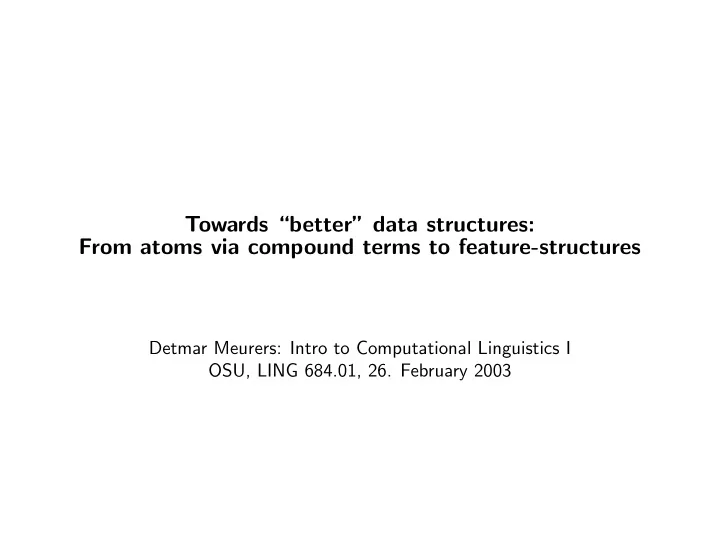

Towards “better” data structures: From atoms via compound terms to feature-structures Detmar Meurers: Intro to Computational Linguistics I OSU, LING 684.01, 26. February 2003
Overview • From atoms to typed-feature structures • What do non-atomic data structures represent? • Combining non-atomic data structures • Term unification • Representing feature structures • Feature structure unification 2
From atoms to typed-feature structures • atoms, e.g. verb_trans_first_sing_fin • compound terms, e.g. verb(first,sing,fin,[noun(first,sing,nom,[]),noun(_,_,acc,[])]) • feature structures, e.g. category: verb, vform: fin, person: first, number: sing, subcat: [(category: noun, case:noun, person:first, number:sing, subcat: []), (category: noun, case:acc, subcat: [])] 3
• typed feature structures, e.g. category: (verb, vform: (fin, agr:(person: first, number: sing)), subcat: [(category: (noun, case:nom, agr: (person:first, number:sing), subcat: [])), (category: (noun, case:acc, subcat: []))]) 4
What do non-atomic data structures represent? s --> np(Per,Num), vp(Per,Num). The rule represents a set of ground instances, one for each possible substitution of a variable with a value. s --> np(first,sing), vp(first,sing). s --> np(second,sing), vp(second,sing). s --> np(third,sing), vp(third,sing). s --> np(first,plur), vp(first,plur). s --> np(second,plur), vp(second,plur). s --> np(third,plur), vp(third,plur). 5
Combining compound terms np(third,sing) --> [he]. np(third,plur) --> [they]. vp(third,sing) --> [walks]. vp(third,plur) --> [walk]. s --> np(Per,Num), vp(Per,Num). Two possible substitutions: • Per = third and Num = sing • Per = third and Num = plur 6
Most general unifiers termUnify(f(X,h(Y, e),g(d(Z),e)), f(Y,h(d(Z),e),g(Y, e))). Which substitution should one report? • X = d(a) • X = d(b) • X = d(h(a,b)) • . . . Compute the most general unifier (MGU): • X = d(Z) 7
Infinite trees • What happens when one unifies – f(X) with X ? – f(a,g(X,b)) with X ? • Add an occurs check to test whether the variable occurs in the term. • In practice too costly. 8
Term unification • A variable unifies with any term it does not occur in. • An atom unifies only with an identical atom. • Compound terms unify – if their functors are identical and – their arguments unify pairwise, and the substitutions obtained as a result of each of these unifications are compatible. 9
Converting predicates to lists (and vice versa) in Prolog Prolog has a built-in predicate =.. to relate predicates to lists, i.e. Predicate =.. [Functor,Arg1,...,ArgN]. For example: functor(a(b),c,d) =.. [functor,a(b),c,d]. This also works for zero-arity functors, i.e. constants: a =.. [a]. 10
Explicit term unification in Prolog termUnify(X,Y) :- (var(X) ;var(Y)), !, X = Y. termUnify(X,Y) :- X =.. [XFunctor|XArgs], Y =.. [YFunctor|YArgs], XFunctor=YFunctor, % test for atom identity unifyArgs(XArgs,YArgs). unifyArgs([],[]). unifyArgs([X|Xs],[Y|Ys]) :- termUnify(X,Y), unifyArgs(Xs,Ys). 11
Representing feature structures in Prolog • The operator “ : ” is defined to separate feature:value ?- op(500,xfy,:). • Feature names and atomic values represented by Prolog atoms • Prolog variables encode structure sharing. • Feature structures represented as Prolog lists with open tails: – [person:third, num:sing|_] – [person:X, num:sing, head:subj:person:X|_] 12
Unifying feature structures in Prolog unify(Dag,Dag) :- !. unify([Feat:Val | Rest1], Dag) :- pathval(Dag,Feat,Val,Rest2), unify(Rest1,Rest2) pathval([Feat:Val1 | Rest], Feat, Val2, Rest) :- !, unify(Val1,Val2). pathval([Dag | Rest], Feat, Val, [Dag | Rest2]) :- pathval(Rest,Feat,Val,Rest2). 13
Towards grammar rules in PATR rule(S,[NP,VP]) :- pathval(S,cat,s,_), pathval(NP,cat,np,_), pathval(VP,cat,vp,_), pathval(NP,per,X,_), pathval(VP,per,X,_), pathval(NP,num,Y,_), pathval(VP,num,Y,_). 14
Grammar rules in PATR ?- op(500,xfy,:). ?- op(500,xfx,--->). ?- op(600,xfy,===). S ---> [NP,VP] :- S:cat === s, NP:cat === np, VP:cat === vp, NP:per === X, VP:per === X, NP:num === Y, VP:num === Y. 15
Assigning a general meaning to “===” X === Y :- denotes(X,Z), denotes(Y,Z). denotes(Var,Var) :- var(Var),!. denotes(Atom,Atom) :- atomic(Atom),!. denotes(Dag:Feat,Value) :- pathval(Dag,Feat,Value,_). pathval([Feat:Val1 | Rest], Feat, Val2, Rest) :- !, unify(Val1,Val2). 16
pathval([Dag | Rest], Feat, Val, [Dag | Rest2]) :- pathval(Rest,Feat,Val,Rest2). 17
Recommend
More recommend